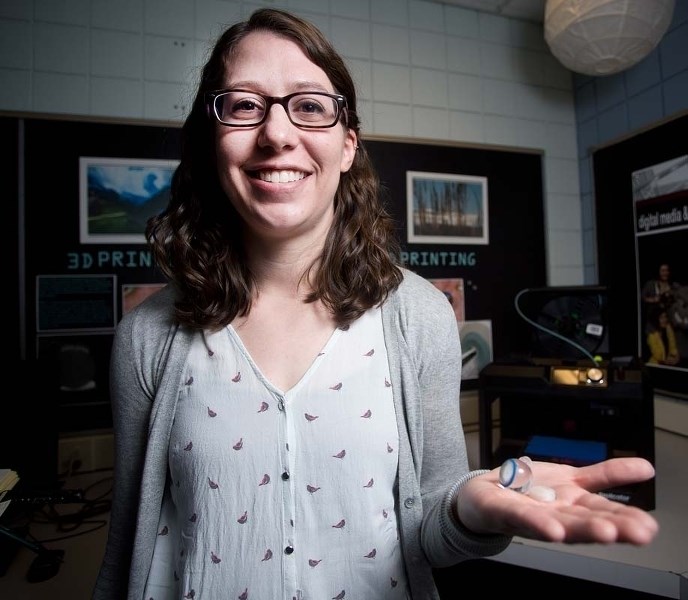A U of A researcher is helping doctors find better ways to treat eye cancer thanks to some technical help from Bellerose Composite.
University of Alberta PhD student Hali Morrison recently built some ocular brachytherapy plaques with the help of Bellerose digital design teacher Mike Larocque and the school's 3D printer.
Ocular brachytherapy is a medical procedure that uses radiation to treat tumours in eyes, Morrison says.
In it, doctors place tiny titanium seeds filled with radioactive iodine onto a silicon disk and stick the disk into a dome-shaped plaque, which is typically made of radiation-blocking gold. The plaque is then sewed to the patient's eye over the tumour, giving it a carefully aimed and calculated dose of radiation (the plate protects the rest of the body from the radiation).
"You can't touch the seeds since they're radioactive," Morrison says, so doctors have to position them using tweezers behind leaded glass.
That, plus the squishiness of the silicon and random jostling, means that these seeds can end up out of position when the plaque is sewn in place, says Matt Larocque, professor of oncology at the U of A, Morrison's supervisor and Mike's brother.
"It's very important we know exactly where they sit," Matt says – if the seeds are out by even half a millimetre, they might zap the wrong part of the eye and let the tumour survive.
Right now, doctors typically have to use more radiation than is needed to eliminate a tumour since they can't be sure the seeds are in the right place, Matt explains. If they can get a better grip on seed position, they can use less radiation and preserve more of a person's sight.
Morrison wanted to look at how the positions of the seeds changed after they were put in the plate. She tried to use a micro-CT scanner to look through the plaque, but found the gold plaque scattered the scan rays and ruined the image.
Enter Bellerose
Morrison says she decided to use a 3D printer to create a transparent model of the plate. That proved challenging, though, as the U of A's printers were expensive to use.
Mike says Bellerose students have had a 3D printer for about a year now, and have used it to print out 3D models of houses and other projects.
"More and more students are seeing this (technology) as a potential career option," he says.
"Right after they graduate, they could be working with this kind of technology."
When Mike spoke to Matt about the printer, Matt mentioned Morrison's project. The three of them decided to use the Bellerose printer to work out the kinks in Morrison's plaque before printing a finished one on the more accurate U of A machines. (These prototype plaques were not used for actual cancer treatments, Matt emphasizes.)
Even though they weren't directly involved in it, Mike says his students have been extremely interested in this project.
"For them to be able to see and start participating in real world applications for this technology is a really powerful experience for them."
The Larocque brothers say they hope this will be the first of many research collaborations between Bellerose and the U of A. Students could help print test eyeballs to see how plaques fit on them, for example, or how the materials in the eye affect radiation, say Matt and Morrison.
"Using the printer is kind of a win-win for us and Bellerose," Matt says, as it lets the U of A refine its prototypes and gives Bellerose a taste of real-world science.
Morrison says she plans to publish the results of her research later this year.




